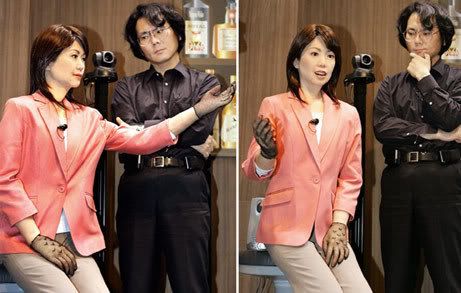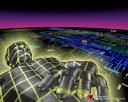LIFELIKE ROBOT

The ultra-lifelike robot Repliee Q1 made quite an impression at the 2005 World Expo in Japan. Shown with co-creator Hiroshi Ishiguru, the robot is so lifelike that roboticists may want to start working on a Bladerunner-style Voight-Kampff test now.
Repliee Q1 has silicone for skin, rather than hard plastic. It has a number of sensors to allow it to react in a manner that appears natural; it appears to flutter its eyelids, chest movements correspond to breathing, and other tiny shifts in position that mimic unconscious human movement. The android can mimic actions made by a human; this helps the robot's movements appear more lifelike. By facing a person with reflective dots placed at key points (like wrist, elbow, palm), the robot can try to match those points on its own body with those of the person who is "modeling" human movement.
The greatest limit to the lifelike movement of the robot is that it has only 31 actuators in its upper body; a nearby air compressor provides the energy needed for articulation.
"She" gestured, blinked, spoke, and even appeared to breathe. Shown with co-creator Hiroshi Ishiguru of Osaka University, the android is partially covered in skinlike silicone. Q1 is powered by a nearby air compressor, and has 31 points of articulation in its upper body.
Internal sensors allow the android to react "naturally." It can block an attempted slap, for example. But it's the little, "unconscious" movements that give the robot its eerie verisimilitude: the slight flutter of the eyelids, the subtle rising and falling of the chest, the constant, nearly imperceptible shifting so familiar to humans.
Surrounded by machines that draw portraits, swat fast-moving balls, and snake through debris, Q1 is only one of the showstoppers at the expo's Prototype Robot Exposition, which aims to showcase Japan's growing role in the robotics industry.
But given Q1's reported glitch-related "spasms" at the expo, it may be a while before androids are escorting tour groups or looking after children—which may be just as well. "When a robot looks too much like the real thing, it's creepy," Hiroshi told the Associated Press.

















<< Home